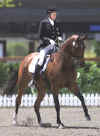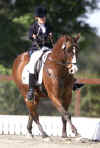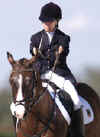|
|
|
|
|
Naši
športniki bodo nastopili v dresurnem jahanju: |
|
|
|
Seznanite
se z osnovami Paraolimpijskega dresurnega jahanja - kliknite tukaj!
Takšna
pa je sestava naše konjeiške reprezentance v Atenah 2004 - ni
dokončna!
|
|
TEKMOVALCI |
ŽELJE
- NAPOVED |
MEDALJE |
|

|
Ana
Humar
|
Čim
boljše uvrstitve na tekmovanjih v organizaciji IPEC-a,
več
o Aninih načrtih > |
|
|
TRENER
|
|
|
|
|
|
|
|
|
Prizorišče
tekmovanj v dresurnem jahanju
|
|
|
|
PREDSTAVITEV
PANOGE
|
|
DRESURNO
JAHANJE
|
|
 Equestrian
is one of the most impressive sports of the Paralympic Games. It
also contributes to the rehabilitation and improvement of
physical skills for people with a disability. Equestrian
is one of the most impressive sports of the Paralympic Games. It
also contributes to the rehabilitation and improvement of
physical skills for people with a disability.
Equestrian
is a multi-disability sport. It is unique among Paralympic
sports since men and women compete on the same terms and horse
and rider are both declared Paralympic medal winners.
Equestrian
at the 2004 Paralympic Games
Dressage
is the only Equestrian discipline that is included in the
competition schedule of the 2004 Paralympic Games. Equestrian
will be held at the
Markopoulo
Olympic Equestrian Centre, in sand arenas 20m wide and 40m
long and 20m wide and 60m long. Dressage will be held
over six competition days, between 22 and 27 September 2004.
|
|
|
|
|
|
|
Although
horse riding has long constituted a means for the
rehabilitation and improvement of the physical skills of
people with a disability, it began to develop as a sport
during the 1970s. The 1984 World Games in New York
marked the beginning of international Dressage
competitions for men and women riders with a disability.
Since then, many international events have taken place.
 The
first Dressage World Championship was held in Sweden in
1987, followed later by similar events in Denmark and
Great Britain. The inclusion of Dressage in the
competition programme of the 1996 Paralympic Games in
Atlanta, with the participation of riders from 16
countries, was a milestone in Equestrian Sports’
history. In the 2000 Paralympic Games in Sydney,
participation increased in a spectacular way, with 72
slots and men and women riders from 24 countries
competing in the Games. In the 2003 World
Championships in Belgium 36 nations entered. By
April 2003, 40 nations were ‘widely practicing’
equestrian sports. The
first Dressage World Championship was held in Sweden in
1987, followed later by similar events in Denmark and
Great Britain. The inclusion of Dressage in the
competition programme of the 1996 Paralympic Games in
Atlanta, with the participation of riders from 16
countries, was a milestone in Equestrian Sports’
history. In the 2000 Paralympic Games in Sydney,
participation increased in a spectacular way, with 72
slots and men and women riders from 24 countries
competing in the Games. In the 2003 World
Championships in Belgium 36 nations entered. By
April 2003, 40 nations were ‘widely practicing’
equestrian sports.
In
1992 the Therapeutic Riding Association of Greece was
founded. This association sees to the rehabilitation and
training of riders with a disability, and intends to
enter at least 3 riders for the Games.
|
|
|
Athletes
with visual impairment, cerebral palsy, amputation or
other physical impairments can compete in Equestrian
Sports. The Equestrian Committee of the International
Paralympic Committee and the International Equestrian
Federation (FEI) rules govern the sport.
The
Event
The
men and women riders perform two programmes: a
predetermined test (Individual Championship) and a
freestyle to music test.
There is also a Team Test that, with the Individual
Championship, determines the result of the all-important
Team Competition (see below).
In the Individual Championship Test, athletes perform a
series of compulsory movements with transitions between
them (walk, trot and, for some riders, canter). The
object of riding dressage is to improve balance,
control, mobility, general fitness, memory and freedom.
The objective for the dressage horse is to develop
physique and ability harmoniously, making the horse
calm, supple, loose and flexible, but also confident,
attentive and keen, thus obtaining perfect understanding
with the rider. It is the aim of the rider to fulfil
both of these objectives, so that the horse gives the
impression of doing of his own accord what is required
of him, submitting generously to the control of the
rider.
The Freestyle to Music test is a competition of artistic
equitation. There are some compulsory movements, but the
tests are free in the form and manner of the
presentation that the rider chooses within a fixed time.
The test should clearly show the unity between rider and
horse as well as rhythm and harmony in all the movements
and transitions. This competition may be compared to the
freestyle ice skating competition.
The
I.P.E.C. accredited International judges assess the
coordination, harmony and accuracy of the movements, as
well as the willingness, obedience and trust of the
horse towards the rider. The final scores, which range
from 0 to 10 for each movement, are added up and shown
as a percentage of all the five judges’ marks.
Each
athlete is classified according to his or her
impairment, or disability, and judged according to their
skill, or ability.
The
Teams participating in the Team Competition consist of
three or four riders from the same country. At least one
of the athletes must be a Grade I or II athlete. The
team’s final score is based on the sum from the best
three performances: if a team consists of four riders,
the worst total score is excluded from the final score.
|
|
|
|
|
Rider’s
clothing
The
rider’s basic items of clothing include: a riding hat,
breeches, riding boots or stout riding shoes with heels
and a jacket. Both men and women riders wear a shirt, a
stock (hunting tie), and gloves – if possible. Spurs
are optional.
Horse
Equipment
Saddle:
The saddle was designed to help the rider maintain his
balance while sitting on the horse. Saddle types differ
for different Equestrian activities. There is an inner
saddletree, which is made of steel, glass fibre or wood.
In most cases, the external part of the saddle is made
of leather.
The
saddle has a girth, which holds the saddle firmly in
place and is similar to a belt.
There
are stirrups for the feet to go in. Riders may choose to
ride without stirrups.
Some saddles may be modified to help compensate for the
impairment of the rider. These modifications
have to be approved by the IPC Equestrian Sport
Commitee.
 Bridle
and Bit: They provide a means of contact and
communication between horse and rider. Grade I & II
athletes use an ordinary single bit (snaffle), while
Grade III and IV athletes may use a snaffle or a double
bridle. Bridle
and Bit: They provide a means of contact and
communication between horse and rider. Grade I & II
athletes use an ordinary single bit (snaffle), while
Grade III and IV athletes may use a snaffle or a double
bridle.
|
|
|
The
riders are assessed according to their impairment and
functional profile and they classified into one of the
four distinct grades - Grade I, Grade II, Grade III and
Grade IV.
Grade
I
Mainly
wheelchair users with poor trunk balance and or
impairment of function in all four limbs, or no trunk
balance and good upper limb function, or moderate trunk
balance with severe impairment of all four limbs.
Grade
II
Mainly
wheelchair users, or those with severe locomotor
impairment involving the trunk and with good to mild
upper limb function, or severe unilateral impairment.
Grade
III
Usually
able to walk without support. Moderate unilateral
impairment, or moderate impairment in four limbs, severe
arm impairment. May need a wheelchair for longer
distances or due to lack of stamina. Total loss of sight
in both eyes, or intellectually impaired. Blacked out
glasses or blindfold must be worn by Profile 36 riders.
Grade
IV
Impairment
in one or two limps, or some visual impairment
The
classification takes also account of a weighting system
for the bode areas most important for riding.
|
|
|
|
|
|
|
|
|
|
|
|
|
|
|
|
|















